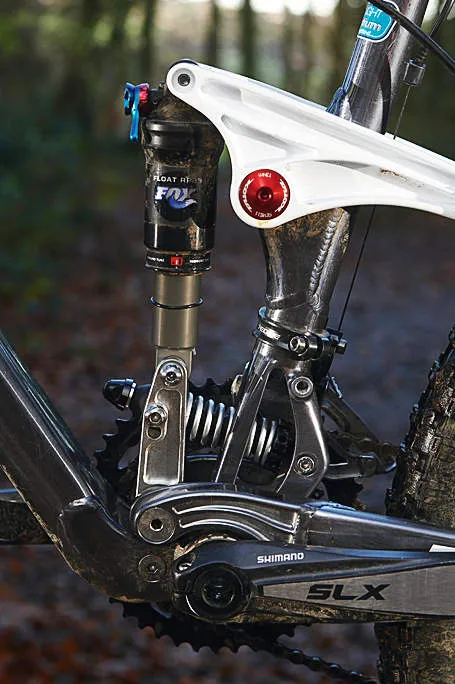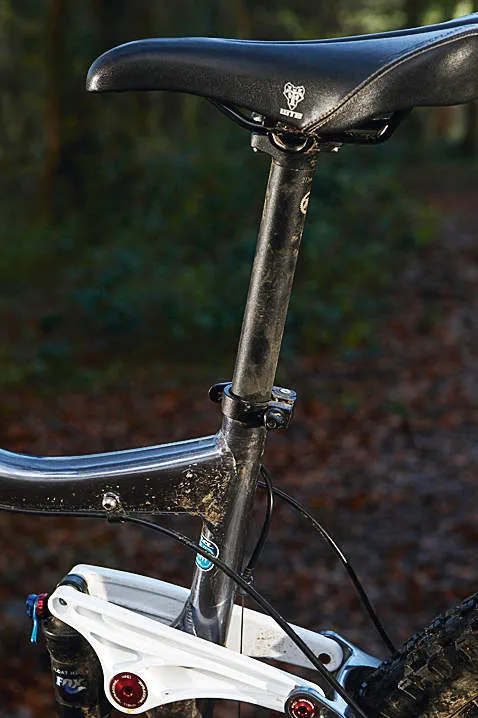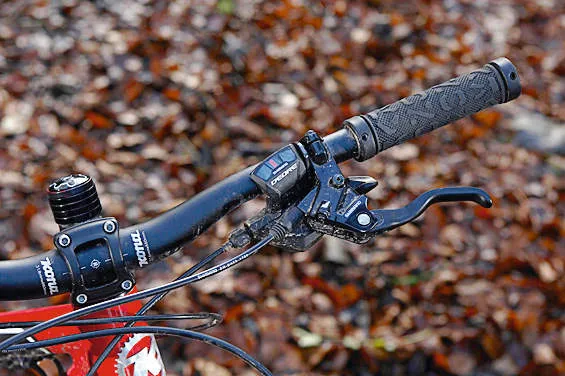The second generation of Kona’s unique twin-spring Magic system is definitely a huge improvement over their 2009 bikes. Does it deliver real tangible advantages on the trail though?
Ride & handling: Light, connected climber and slacker, smooth descender
The initial ride feel is more cross-country than you might expect for a 160mm (6.3in) travel bike. The head angle gives quick steering through the short stem while a steep seat angle and inline post put your weight forwards over the bars. The tall bottom bracket gives you a very planted climbing or singletrack bike with loads of ground clearance and bags of front wheel traction.
But unlike most low pivot bikes, the short stroke air shock keeps pedalling manners taut enough to get your torque on without relying on the ProPedal compression damping lever. Its small bump response is accurate and supple enough for sticking the rear wheel down and turning this bike into an outstanding technical climber too.
While brakes and handling might not naturally encourage high-speed, high-risk riding, that’s exactly when the Magic suspension system makes its presence felt. As the second spring kicks in, it slackens the angles and extends the effective chainstay length and wheelbase at the same time, for a slacker, more stable and speed-friendly feel.
Kona have obviously worked really hard on the 2010 Magic to iron out the previous flex and auxiliary shock top-out issues. The transition between the two springs is impressively seamless, with less wallow than a lot of similar travel bikes that use large-volume air shocks.
Apart from wheel twang, the back end feels rock solid when you’re cutting and carving too, combining with the tapered screw-through fork for a much keener overall handling feel.
Frame: The ‘Magic’ twin spring suspension system is now seamless and flex-free
Kona are one of the few companies to have stuck with scandium alloy through its brittle bike development period. The highly hydroformed and lifetime-warrantied Cadabra frame proves it’s been worth it. The short, stout integrated head tube with shiny new headbadge takes a tapered 1.5in to 1.125in fork steerer, while the curved top tube retains good standover clearance.
Rather than stick with the previous horribly flexible, extra long chainstay routing, Kona have now curved the chainstays over the top of the BB. The big offside chainstay runs straight to the lower pivot for maximum stiffness too. A crisp, forged, machined seatstay bridge and deep rocker links complete the clean and deceptively simple looking suspension set-up.
DOPE replaceable rear dropouts add easy repairability and hub versatility to the mix and there’s space inside the frame for a proper bottle mount. You get nearly 11in of seatpost drop for steep descents while six different frame sizes ensure an accurate fit.
So far we’ve had no problems to suggest that the Magic mechanism undermines Kona’s legendary reliability reputation. It’s not significantly heavier than conventional bikes either.
Equipment: Impressive spec and weight for the money considering the frame complexity
Kona have really pulled out the stops on the equipment value of their bikes for 2010. The Fox Float fixed travel 150mm (5.9in) fork gets a 15QR screw-through axle to stiffen it, as well as lockout for climbing. While this 2009 open bath fork is heavier than the 2010 FIT cartridge versions, it’s actually more supple over small stuff.
SLX cranks are our favourite durable but light set-up, so we’re pleased to see them here. The XT/ Deore mix works smoothly and the KMC chain has a split-link for easy maintenance. Mavic CrossRide wheels look good and keep the whole bike lighter, responsive and more manageable on the climbs. They are on the skinny side though, which can make the already fragile Kenda tyres more prone to punctures and rolling. They twang around a bit at high loads too. Some testers preferred a layback seatpost – rather than the inline one fitted here – because it created a less forward-biased feel.
The 75mm stem keeps the steering light, but a bike this capable deserves a wider bar to help it take the fight to the trail. The Shimano brakes lack initial bite and subtle feel too, although they stop eventually if you pull them hard enough.





